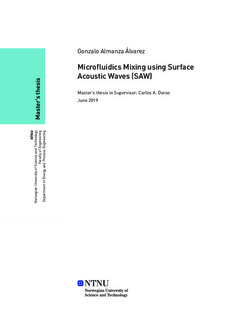| dc.description.abstract | Nanoparticles detection by sensors uses samples quantities in the order of 〖10〗^(-9)-〖10〗^(-18) L. Due to its inherent low Reynolds numbers, laminar flow is dominant in microfluidics, what leads to no fluid mixing and the need of an external force for achieving this. Mixing in these devices is necessary for enhance the contact between the sensor and the analyte, in order to improve the sensing efficiency.
In this project, mixing enhancement of microfluidics will be studied by the apply of Surface Acoustic Waves (SAW). When SAW are propagated through a substrate surface and get in contact with a fluid, they provoke a stirring on it and eventually, when the power is enough, they break the laminar flow and mix the fluid. For this goal, a microfluidic mixer will be fabricated, using a nano- and microfabrication method called “Photolithography”. This will be formed by a PDMS microchannel, for sample management, and an Interdigital Transducer (IDT), over a piezoelectric substrate, for the producing of SAW and fluid mixing.
During the first stage of the project, the device fabrication processes was developed and optimized. Then, these devices were tested using a syringe pump, a SAW generator, a microscope, different light wavelengths and a fluorescent dye. Mixing is studied using flow rates from 600 to 6000L/h and power with a maximum of 2,57W, which is limited by bubbles appearance inside the microchannel.
High efficiency mixing was achieved for flow rates from 600 to 1000L/h, with future expectative of even higher flow rates mixing. Using a smaller microchannel that the ones found in the literature, we got results comparable to recent publications. Mixing results were compared in function of the distance between the IDT and the microchannel, so we could check that the closer the IDT, the higher the mixing. Related to the use of a Single IDT or two IDTs (Dual IDT), it was found that Dual IDT mixing is higher than Single IDT´s, however this has a power limitation. Testing of different IDT designs was performed. | |
